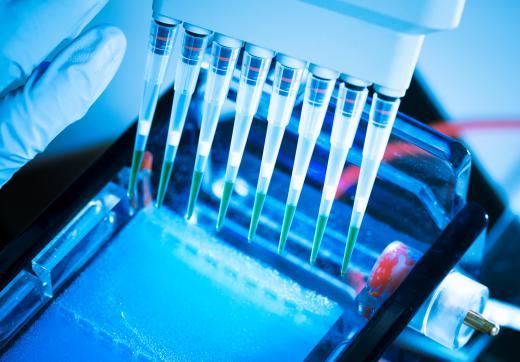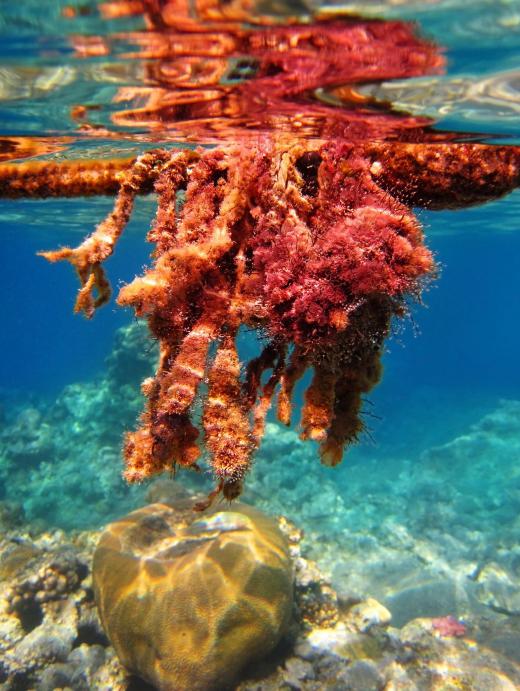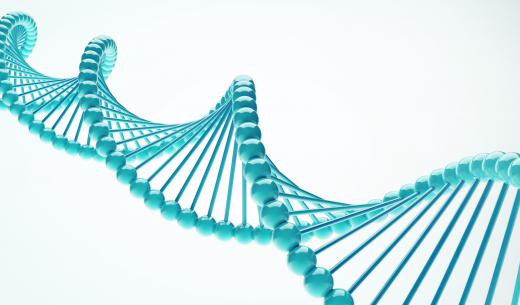What is Agarose Gel?
Agarose gel is a substance that is used in biochemistry and biotechnology for gel electrophoresis and size exclusion chromatography, which are methods of sorting large molecules by their size and electrical charge. These processes use agarose to separate and analyze proteins and DNA. It is very suitable for these applications because of its molecular structure, which allows different sized molecules to move through it at different rates. The material is obtained from various types of seaweed, and is usually found in laboratories in powdered form. To make a suitable medium for a given test, the powder is added to water at the appropriate concentration, boiled, and then allowed to cool into a gel.
Manufacture

Agarose is extracted in the form of agar from several species of red marine algae, or seaweed, found in California and eastern Asia. Agar, a term derived from the Malay word agar-agar, meaning jelly, is typically obtained from the Gelidium types of seaweed. It is composed of two different substances, known as agarose and agaropectin, and provides support to the cell walls within the marine algae. When removed, the agar can be used as a food thickener, much like gelatin, or as a laxative. If purified, it can be used as a medium for growing bacteria, fungi, or other microorganisms.

It is fairly easy to separate agarose from agaropectin in agar because the agarose molecules bond strongly to one another, while the agaropectin gels poorly. There are several methods to achieve the isolation of agarose. In one method, carrageenan, another molecule found in red seaweed, and a salt are added to the agar. This causes the agaropectin to precipitate, or form a solid that can be removed from the agar solution. Another method adds the enzyme pectinase, a chemical that breaks down the agaropectin, allowing it to dissolve in water.
Gel Electrophoresis

Agarose gel is most commonly associated with electrophoresis. In this procedure, scientists apply an electric field across a slab of the material containing dissolved DNA, RNA or protein fragments. This causes these large molecules to move because of their electrical charges: positively charged types will move towards the negative side, and vice versa. DNA and RNA fragments have a negative charge, and so will move toward the positive end, whereas protein fragments can be either negative or positive.
The speed at which the molecules move depends on their size, and on how much charge they have. Agarose gel is structured in such a way that it forms a kind of mesh, with holes through which other molecules can travel. It is easier for smaller ones to go through the holes, and so they travel more quickly. Among larger molecules, shape also plays a part, in that the more compact ones with go through more easily. The technique is used both to analyze samples and to isolate particular sequences of DNA for use in biotechnological applications.
Prior to electrophoresis, a DNA sample would be treated with special enzymes that cut the long, strand-like molecules at specific places, making smaller fragments. The agarose gel is prepared by dissolving the powder in a buffer solution, which resists changes to pH — acidity/alkalinity — that might otherwise result from electrochemical effects. Different amounts of powder are used for different ranges of molecules, but usually the concentration is between 0.7 and 1.2%. A fluorescent dye called ethidium bromide is usually added at this point, as it stains DNA, and makes it easily visible under ultraviolet light. This mixture is then microwaved and allowed to set.
The DNA samples are put into small wells in the gel, and a direct electrical current is applied across it. Different sized molecules travel across the gel at different rates, so after a given time they will appear at different positions, with the smaller fragments further toward the positive end. This enables scientists to determine the sizes of the fragments, and to isolate different DNA sequences.
Other Uses
Agarose gel is sometimes used in a related technique that does not involve electricity, known as size exclusion chromatography. In this method, a glass column is packed with beads made out of gel, and a solution containing different sized molecules is poured in. In contrast to electrophoresis, the larger molecules move more quickly down the column to emerge at the bottom, while the progress of smaller ones is slowed in the beads. This is because the small molecules tend to be absorbed into the pores in the gel, while the larger ones are too big to enter these pores and tend instead to flow between the beads. The gel type and concentration can be adjusted to suit the sizes of molecule to be separated.
AS FEATURED ON:
AS FEATURED ON:













Discussion Comments
Can someone explain to me a little more about denaturing agarose gel electrophoresis?
I know that it's connected with RNA, and checking RNA preparations, but I just don't understand how it works.
I've got a test on this on Monday, can somebody please clear it up for me?
Thanks for this article -- I just started my required science class for Uni, and they keep throwing all these new terms at me that I have absolutely no way of keeping up with.
We don't use agarose gel apparatus in our lab, but the professor still wants us to know the agarose gel protocol, and to be albe to spell out the process of agarose gel electrophoresis for a test -- I honestly have no idea why, since we're not going to do it...
However, thanks for the clear article. Really helped me out.
Post your comments